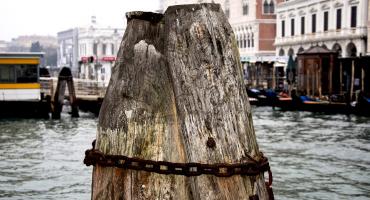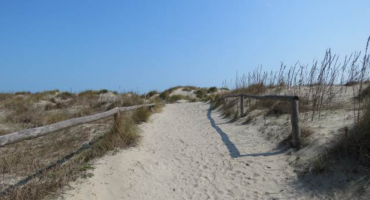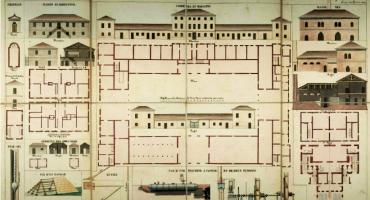This itinerary between sea and lagoon, between history and environment, to be done by bicycle along the narrow strip of sand of the coast that separates Venice and its lagoon from the Adriatic sea, from velvet beaches to liberty-style villas of Lido, from fishermen villages in Pellestrina and in San Pietro in Volta until naturalistic oasis of Ca’ Roman, last stage before meeting Chioggia and its lagoon.
1° stage: (2 h) We choose as a starting point of this itinerary the wharf of Ferry Boat which, from the island of Tronchetto transports people and cars to Lido. We get off at San Nicolò, the west end of Lido, where there is the first of three mouths of Venice port, the one which separates the coast of Cavallino from the one of Lido, shaping itself for centuries from river sediments and from works of man in order to protect the lagoon of Venice from the sea. Utilised during Serinissima as an integrated military system, together with other islands of the north lagoon, and as a shelter for mercenaries that set off to expeditions, in this furthest end of the coast stood up a Fort whose few traces have remained near the majestic 16th century bridge made of bricks and Istrian stone (every year marriage of Venice to the sea is celebrated here during a charming ceremony of Festa della Sensa). On the other hand, Fort of Sant’Andrea, built in 1543 is still visible on the other side, between Certosa and Vignole.
Before we embark on our cycle ride along 12 km that separate the dam of San Nicoletto from the tiny port of Malamocco where we’ll get aboard for the next island, we can have our first stopover to visit nearby architectural Benedictine complex of San Nicolò which now hosts students of European Master in Human Rights. Founded in 11th century and run by Franciscan Friars, it includes a small church, reconstructed in 18th century, which still preserves Corinthian columns and capitals, a renaissance cloister from 16th century with its real well-curb and a convent. Not very far from the church we can have a break in front of the tiny black iron gate of the ancient Jewish cemetery, instituted in 1489 and restored in 1999, and have a glimpse inside this charming silent garden where trees and gravestones live together in harmony.
2° stage: (2 h) We leave the lagoon side and continue on the promenade Lungomare d’Annunzio, a street busy only during summer, running along the strip of sand where bathing establishments with their rows of “cabins” follow one after another (joys and sorrows of Venetians who save all year round in order to be able to rent them at dear price during summer months!) and we arrive to the crowded centre of Lido that expands around 17th century Church of Santa Maria Elisabetta, close to waterbus stop, where a large copper cupola of the votive temple rises, today assigned to Military Sanctuary and visible as you arrive from Venice. We leave on our right Gran Viale, which arrives from the lagoon until the sea, and going across the crossing we arrive to the seafront Marconi, in the “City Garden”, constructed at the beginning of 20th century, in full Liberty and art deco style. Apart from the private residences we come across early 20th century great hotels frequented by Hollywood divas, queens and great writers, Des Bains is a bit further from Excelsior, with striking New Moorish architecture, constructed in 1907 and which, with their elegant bathing establishments have transformed Lido in one of the most chic touristic localities in the world since the beginning of 20th century. Between them there is Casinò, opened in the Thirties and of Fascistic architecture, and Cinema Palace, venue of the famous International Show of Cinematographic Art.
We leave the road and continue on the cycling lane of Murazzi, a fortress of Istrian stone accomplished in 1751 by Serenissima to defend the coast and the lagoon from sea storms, until we arrive to Alberoni, a nature reserve area, and to the dam of Malamocco. Along Murazzi and particularly along Alberoni, the coast, which is here characterised by presence of dunes that can be even 9 metres high, offers interesting naturalistic and landscape ideas, between rich semi-wild vegetation at the edge of the dunes and imposing sandy dunes, an ideal habitat for diverse species of sea birds such as Kentish plovers, little egrets and seagulls.
From here, going along the old Military Fort of Alberoni (today premises of a Golf Club), we can reach a picturesque lagoon village of Malamocco, arose in 12th century after a violent sea storm had destructed the ancient Metamaucus, situated near the island of Poveglia and once doges and bishops’ offices. Don’t miss a brief visit to Calle delle Mercerie and to a small church to admire the lively Miracle of Madonna by Forabosco, which represents the rescue of survivors after a storm.
We go back towards the mouth of Malamocco port, towards Rocket Fort where we can have a break before going aboard another Ferry Boat that will take us to Santa Maria del Mare.
{mospagebreak}
3° stage: (3 h) Once we cross the canal of Malamocco, protected by famous Murazzi, our cycling trip continues for another 11 km from Santa Maria del Mare to the dam of Ca’ Roman, in front of which, beside another port mouth, rise the red tops of bell towers of Chioggia.
We enter into the one that is the most charming part of the cycling trip, where the long strip of sand of the coast becomes narrower and narrower until it becomes only few metres wide in some points and where Venice can not be distinguished any longer on the horizon but only a blurred landscape beyond which the south lagoon spreads out with the valleys of Romea: Averto valley, Zappa valley, Millecamp valley, enormous incubators of numerous animal species and areas of “alive lagoon” where, amongst brackish and salt waters there live fishermen, fishes and migratory birds.
Along the lagoon coast we come across fishermen villages and market gardeners of San Pietro in Volta, Portosecco and Pellestrina, little hit by crowds of tourists and, unlike the ones we find in the north lagoon, grouped together around a centre or a canal, prolonged in thin line between the lagoon surrounded by houses, and Murazzi behind that protect them from the sea. Here, amongst vegetable gardens protected by grisiole, old inns where it’s still possible to taste characteristic fish snacks (ideal for a break an maybe for a quick lunch before continuing towards Ca’Roman), and fishing boats lined along the shore, tightly clenched and tiny and humble coloured houses follow one after the other and sometimes in atmosphere outside time, rich in glamour and charm, where relationship between man and lagoon is still linked to rhythms of fishing and agriculture and where sense of territorial identity is still very strong and exclusive. We suggest that you have a stopover in Pellestrina to visit a small medieval church of All Saints (Ognissanti) and allow to be enchanted by the time rhythm and slow and shuffling language of these islanders, hoping to still meet some women busy with lacework (just like on Burano!), outside the front door.
After a break, we go beyond the cemetery of Pellestrina and cycle for about one kilometre along mighty Murazzi, few meters away from the sea, until we arrive to the most southern point of the coast, into naturalistic oasis protected by Ca’ Roman, refuge for many floro-faunistic species, and green lung of the island, which extends for about forty hectares of wild beach, dune and scrub. In the exuberant pinewood at the edge of the dunes and on the white sandy beach it is possible to catch sight of Kingfishers, Cuckoos and Herring Gulls and, during periods of nest-building, Kentish Plovers and Little Terns, two rare species that have chosen this silent and deserted area, where tourists seldom arrive, as the ideal place for reproduction. Before re-taking your bicycle to go back, we can have a look at the dam of Ca’ Roman from where it’s possible to make out in the distance, beyond the canal, Chioggia with its port. Next to the port mouth of Chioggia, along the coast and the canal of Ca’ Roman, we can see actually see what has remained from the ancient fort of Ca’ Roman, known as Fort Barbarigo after the name of coastal defence battery built inside of it in 1912. Built in 1800 and still today belonging to the Navy, it has been used for years as marine colony of Canossian mothers and it’s Venice Council’s intention to insert it into circuit of visits of Venetian Fortresses through agreements with Maritime Military Department of the Adriatic.
Indicative length of journey: one day
Extent of journey: about 50 km
Advisable period: spring - summer (avoiding too hot and sunny summer periods!)
The Italian League for Bird Protection organises for months of May and June a cycle of free guided tours on the discovery of this splendid natural oasis. Expecting length of tour is two hours. For information visit website http://lipuve.provincia.venezia.it/attivsez.htm
Once every month ACTV runs a special tour: Mainland and Lagoon: Guided Tour from San Giuliano to Sant’Erasmo by Boat and Bicycle
For information:
HelloVenezia
Tel: 3458413806
Website: www.hellovenezia.it



